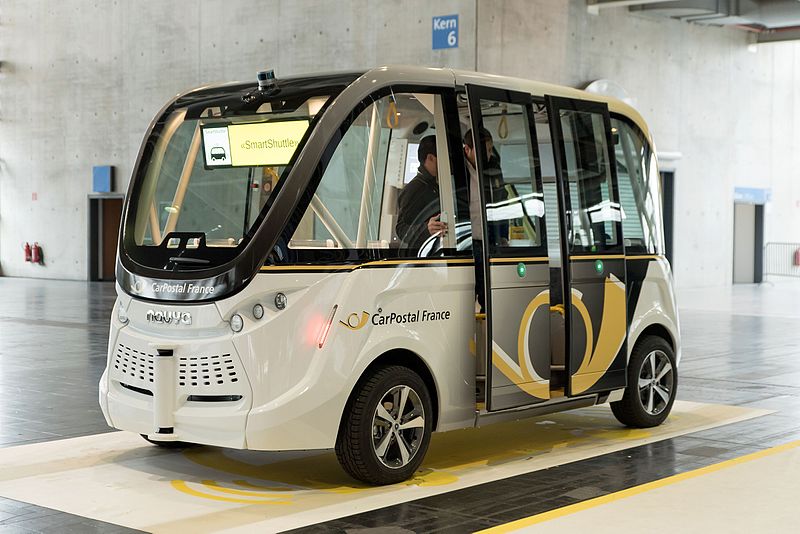Tech companies are changing how human beings move around. Self driving carscould make human driving a thing of the past. Technologies like the hyperloop could make humans move at speeds that were previously thought impossible through the deserts of California. Automobile transport is something that simplifies the movement both within the city and between large destinations. Therefore, many people take a car on a trip, because this is the most convenient way to travel available to everyone. If you wish to travel with comfort while having a big company there is one proven way for doing that using 7 passenger minivan rental for any purposes
But an overlooked part of people’s vision of transport of the future is the humble bus. Automakers are trying to invent something new and unique buses that . The next 5 innovative buses will amaze you with their futurism and various technological innovations used in them.
Navya Arma Minibus

The French development, which has already passed the first tests on the streets of Switzerland, is a 15-seat minibus with the maximum speed of 45 km/h.
This high-tech unmanned shuttle is equipped with a GPS navigator, motion sensors, lidars, security systems and surveillance cameras, allowing it to navigate perfectly on city streets, recognize moving objects and identify traffic signs. Air conditioning provides additional comfort for passengers.
Although its work is autonomous, the so-called ‘driver’ is placed in the cabin for safety reasons. Shuttle operation is remotely controlled by the operator, and an alarm button is located in the cabin.
The shuttle has quite compact dimensions: 4.7 meters long, 2 meters wide, 2.5 meters high and a clearance of 200 mm. The reserve battery allows the vehicle to always stay on the go, while the 34-horsepower electric motor itself receives a charge from a lithium-iron phosphate battery, which guarantees a cruising range of 5-8 hours depending on operating conditions.
Transit Elevated Bus
Chinese engineers, who are prone to futuristic development, created a unique transport. The two-tier bus has seats on the second floor, and the first floor is a kind of tunnel that passes automobile traffic underneath. Thus, this bus hovering over the road is not only able to carry up to 1000 passengers, but also save drivers from kilometers-long traffic jams.
Although trucks for the most part won’t pass in height into the portal, but for easy transport, traffic lights are provided on the sides of the bus for easy travel or overtaking.
The battery-powered portal is 22 meters long with a width of 7.8 meters and almost 5 meters high, which is why passengers have a high platform for access to the interior. It’s assumed that it will move on special rails laid on city roads, and will be able to transport a large number of people at once.
Superbus
Another unique project that resembles an ultramodern limousine is the Dutch development for intercity travel, accommodating about 23 people and moving at a speed of 250 km/h.
With a 10-ton weight and a 15-meter length, it has a stunning power of 408 hp. under the hood. Amazing transport is driven by electric motors launched by a lithium-polymer battery.
The body of an electric bus is made of lightweight reinforced fiberglass, while the chassis and the frame are made of carbon fiber. Eight pairs of doors open vertically upward, and the interior is equipped with seat belts and airbags, air conditioning, a TV and the Internet
Supplied with the latest technologies, including radar, navigators, electronic assistants, the bus will be able to timely recognize people and other objects on the road to avoid collisions.
Mercedes-Benz Future Bus
The beautiful brainchild of Mercedes-Benz drives along the route from Schiphol Airport in the Netherlands to the center of the capital. The unmanned bus is controlled by the autonomous CityPilot system, which offers all the possibilities of an ordinary driver: following the route, an independent stop at passenger boarding points, and observing traffic rules.
A dozen cameras continuously scanning the road, 4 radars for monitoring the space of 0.5-10 meters around the bus, 2 stereo cameras for viewing distances of up to 50 meters, radar systems, GPS – all this equipment guarantees maximum safety for passengers, pedestrians and other road customers.
True, although the bus runs on a constant basis, a real driver observes its work to bring all systems to perfect condition.
Credo E-Bone
The Hungary-manufactured bus of the new generation is designed to help preserve the environment, and therefore works not even on electricity, but on hydrogen fuel.
Engineers placed the charging elements on the roof, where they are powered by lithium-ion batteries. The vehicle, made of lightweight composite plastic, is powered by 4 electric motors integrated into the wheels of the bus.
Light weight allows the bus to consume a little energy during trips: in urban mode it will be powered by batteries and at high speed on the highway hydrogen fuel will be used. And while this concept exists in a single copy, its author is sure that it has the right to exist, and therefore it will certainly be launched into mass production.
